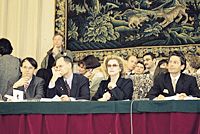In 1794, the harvest was put up for
sale by means of billposting. The wine merchants deposited an envelope containing the
price they were offering on the site of sale itself. The highest offer received the market
under the sine qua non condition of having respected the lower price limit fixed by the
administration. If this price was not reached, the auction was simply postponed.
1820 : the institution decided to
proceed by public auctions. Although this system was valid, it took several years to
become successful... and required the energy of a man called Joseph Pétasse, steward from
the Hospices de Beaune, who largely contributed to the fame of the Burgundy wines.
Pétasse, an untiring ambassador of the Hospices, a wine merchant and a man of letters,
toured Europe proclaiming the virtues and the quality of the Burgundy wines to potential
buyers. His exhausting actions were crowned with success: in less than two years, Pétasse
sold the entire stock of the Hospices to wine merchants! This man was duly proud of his
feat and rightly declared to the administrators: "Gentlemen, you may resume public
auctions this very year. We no longer need to bother: the clientèle is assured, our wines
are known and from now on the wine lovers will come to us!". The future confirmed
these daring words.
1924 : the date of wine auction is
definitely fixed on the third Sunday of November. At the outset, it took place in the
courtyard of the Hôtel-Dieu, and was later transferred to the fermenting facility between
1925 and 1958.
The Hospices were again very successful. Indeed, the following year the merchants had to
come to the Halle de Beaune, larger and more accessible. The success of the annual auction
did not mislead the administrators, who tolerated no concessions as to the quality of
"their" wines: the 1956 and 1968 vintages were not put up for sale, and the
corresponding auctions were canceled, since the production was judged to be
"mediocre".
The flame is solemn
On the big day, the Mayor of Beaune in his quality of president of the board of directors,
along with the administrators, the director and his collaborators, as well as the
auctioneer receive an important person: the president of honor.
Chosen among the members of the highest royal families in Europe (Otto of Habsburg, the Duke of Kent...),
 |
|
or
in more recent times, among the most prestigious persons in the fields of arts and letters
(Catherine Deneuve, Barbara
Hendricks, Lino Ventura, Rostropovitch), this patron - or matron - receives a cask of wine of some 300
bottles, which are immediately put up for sale.
The benefits from the sale of the cask are donated in their entirety to a charity
organization of his - or her - choice.
|
The
impassive officers seat themselves at the gallery. The buyers also take their places. The
noise ebbs. The bidding can begin. Lower price limit: 1,000 Francs. The procedure is
always the same: bidding proceeds with candlelight, under the attentive eye of the
auctioneer.
During two lights, that is while two candles burn, the buyers make their offers. The size
of the candles is determined by the initial offer. This solemn and highly symbolic
procedure has no true influence on the sale : however, it grants the potential buyers time
to think.
With the exception of the charity cask, all vintages are sold as lots. The French and
foreign wine specialists give special attention to the prices. If they are higher than the
market ones, they nevertheless reflect the first rate of the production.
"Covered" by the media of the whole world, the auction is also the occasion for
wine merchants to gain publicity profitable to their brand image. This reputation is not
only due to the television coverage : in order to have their name printed on the labels of
the Hospices de Beaune, the buyers must respect a severe list of obligations, particularly
to grow their wine in the wine-growing region of Burgundy and to use traditional bottle
formats (75 cl).
Lastly, the art of wine being equaled only by the art of the table, the bidding ends
around a large table, as a candle-lit gala feast illuminates the Bastion of the Hospices
and its medieval stones.
Traditional Auction, a brief
description:
Since 1931, directed by an auctioneer commissioner
The atmosphere in the Auction Room may be described by three words
Serious
Quiet
Focused on the event
The auctioneer commissioner starts the session by announcing the different legal issues
and briefly describes the different lots (a set of barrels).
The auctioneer commissioner gives a precise description of each lot (number of pieces,
vintage, mark guaranteeing the quality of the wine).
An initial amount is fixed for each lot.
The "crieur" (crieur, the man who
shout the current bid), seated just near the auctioneer commissioner, is a man whose role
is to stimulate and motivate the bidders.
In the room, for each row, "rabatteurs" will broadcast the
bidder's auctions . Those will be shouted by the "crieur".
For each lot, a starting candle is lit up, thus phasing the auction. The phase for one lot
is based on the use of three candles which will be light up and blow out (successively).
At the end of the last candle (the third), the auctioneer commissioner will take again
speak. He will announce the end of the auction for the current lot and prepare the bidders
to knock down (going, going, done !). Bidders are required to close their last offers, and
the lot is sold for the best auction.
A "rabatteur" will transmit Bidder's Identity to the auctioneer commissioner who
will announce it in the microphone.
The following auction could now start.
The average cycle for one lot is about 5 minutes.

